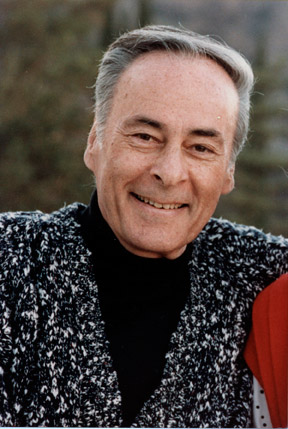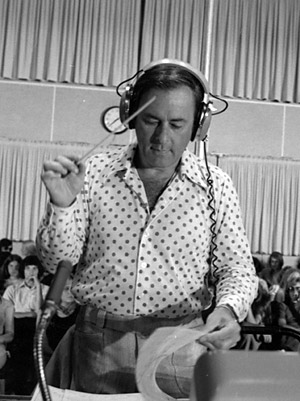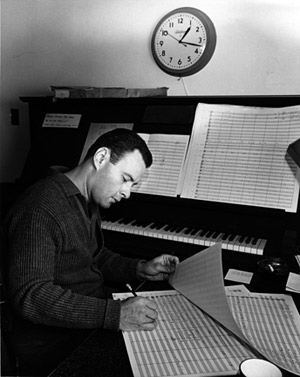

  |
|
|
||||||||||||||||||||||
|
FMS FEATURE... August 20, 2010 Morton Stevens Revisited Composer of Hawaii Five-0 helped define '60s, '70s TV scoring by Jon Burlingame  Morton Stevens, 1990. Like many composers of classic TV themes, Stevens' name was unfamiliar to most viewers. But although his fame may not have extended beyond the borders of Hollywood, there he was a well-known and respected talent. Hawaii Five-0, which he wrote in 1968, was one of many themes he wrote during his three decades in the film and TV business. It just happens to be the one everybody knows. Stevens was among the hippest TV theme writers of that pre-Mike Post era. His success with Five-0 – in part because of The Ventures' top-10 hit with the tune – taught him to utilize more contemporary pop and rock sounds than many of his colleagues. His other big hit was Police Woman (1974), for the Angie Dickinson cop drama. Its piercing synthesizer opening, that smash-you-in-the-face brass and arresting Brazilian beat earned him one of his nine Emmy nominations. But Stevens won two Emmys (and a third nomination) for the music of Hawaii Five-0, and it's his powerful brass and woodwind writing, combined with a driving rock 'n' roll rhythm section, that created such a sensation – and which CBS, for its new weekly series, has insisted sound as much as possible like Stevens' original. "That theme is so iconic, it's in the culture," says composer Brian Tyler, who re-recorded the theme. "If you take it out of the instrumentation and change it up, you might have interesting music, but it isn't Hawaii Five-0." So CBS unearthed Stevens' original 1968 arrangement, Tyler analyzed it – Stevens made some last-minute changes at the recording session that aren't reflected in the original scores – and recorded three lengths for the series (1:45, 1:00 and 0:30, the last of which is expected to be heard over the main title sequence). Tyler will also be scoring the series with Keith Power. "Somehow Stevens was able to completely capture the concept," adds Tyler. "Imagine someone telling him the story, when the show was being pitched: It takes place in Hawaii, surf and fun and kinda sexy, but it also has to be gritty and exciting and dramatic. What that theme had to do was so unusual that it made for something unique. And he did pull it off, so it's unforgettable." I interviewed Stevens in September 1991, several weeks before his untimely death at the age of 62. He recalled the origins of his famous tune, and admitted that he knew it was something special. "You know how you know you've written something right? I knew it was right. Now that theme could have gone right down the tubes, had Hawaii Five-0 not been successful," he added. He said he thought "the simplicity of it – the driving force of instruments rather than simply the drums, helped to make it into a popular rhythmic entity."  Stevens conducting a recording session for Hawaii Five-0. But the surprising success of The Ventures' single of the theme, which reached no. 4 in the spring of 1969, helped to solidify Stevens' composition as one of TV's best-known themes. (Both the composer and the rock group were cheated out of a Grammy nomination, and thus a possible win, by the fact that the single was released in September 1968 and thus ineligible for the 1969 Grammys. Stevens' sole Grammy nomination is for music on the 1965 Man From U.N.C.L.E. album.) Five-0 creator-producer Leonard Freeman, who once referred to Stevens as "a stone cold genius," had asked him for music that reflected "a kind of melding of the Polynesian, the classic, the jazz and most of all the pop sound of today.... No ukeleles or steel guitars or falsetto singers or overused bongos." Police Woman producer Douglas Benton told me in 1993 that Stevens was "the most versatile composer I ever had the pleasure of working with. All you'd have to say was Puccini or Rachmaninoff, he could work himself into that mood and the score would come out that way. And of course he wrote great jazz." Stevens' other TV themes demonstrated that versatility. His first was for another cop show, 87th Precinct (1962), with its staccato, nervous-energy feel. In the aftermath of The Ventures' success with Five-0, the composer invited the group to play his rockin', electric-guitar-dominated theme for the idealistic young attorneys of The Storefront Lawyers (1970), which he replaced with a more conventional theme when the show was retooled as Men at Law (1971). Add to those the homespun Americana of his theme for the gentle Ronny Cox drama Apple's Way (1974), an appropriately smart-aleck signature for Tony Franciosa as Matt Helm (1975), the heroic tone of Spencer's Pilots (1976) and the urgency of Code Red (1981). Two others, however, rank among his finest work for the small screen: The Chinese instruments, frantic strings and pure excitement of his music for the short-lived Khigh Dhiegh detective series Khan! (1975), and the elegance of his theme for the CBS Thursday Night Movie (1965, and later the longrunning CBS Late Movie), with its dignified French horn line and brassy big-band finish. Stevens fell into the world of film and TV scoring by accident. Born in Newark, N.J., he graduated from the prestigious Juilliard School of Music and immediately found work as a top woodwind player (clarinet, saxophone, flute); he was also a talented arranger. He met Sammy Davis Jr. in 1950 and before long was on the road with the entertainer as his arranger and conductor. Stevens was musical director on Davis' Broadway show Mr. Wonderful for a year starting in the spring of 1956. It was Davis who launched Stevens' scoring career by insisting that his personal music man score his guest appearance on a 1960 General Electric Theater. By the fall of 1960 Stevens was scoring Revue (later Universal TV) series on a weekly basis: episodes of Thriller, Tales of Wells Fargo, Wagon Train, Checkmate, Wide Country, his own 87th Precinct and even a Universal feature, the Tony Curtis comedy Wild and Wonderful. He soon moved over to MGM to score Cain's Hundred, Dr. Kildare and The Man From U.N.C.L.E.; the latter proved so successful he scored an U.N.C.L.E. feature, The Spy With My Face. At other studios he worked on Ben Casey, Breaking Point and Voyage to the Bottom of the Sea. In 1965 Stevens became director of music for CBS West Coast Operations. In that capacity, he supervised all scoring for the shows that the network itself produced, including Gunsmoke, The Wild Wild West, Perry Mason, Cimarron Strip and others (often writing full scores, or partial ones, for all of them), eventually including Hawaii Five-0. Along the way, he scored a number of TV-movies that have become classics of the genre, including She Waits (1972, a haunting, strings-and-harpsichord theme that just oozed mystery and quiet horror) and The Horror at 37,000 Feet (1973, with moaning choral effects and a half-dozen murmuring oboes). Stevens left CBS in 1977, giving him the chance to tackle such major miniseries as the 10-hour Arthur Hailey saga Wheels (1978, rhythm-driven yet expansive), the nine-hour historical drama Backstairs at the White House (1979, classically styled) and the six-hour The Manions of America (1981, rich in Irish flavors). Yet Stevens remained loyal to the shows that made him a sought-after composer in TV. All told, he did about 40 episodes of Five-0, returning nearly every season to score at least one and sometimes four or five. "After I left CBS, I still worked on the show," Stevens said in 1991. "Jack Lord came in and said, 'Morty, we want to you to give us at least five shows a year. Please,' and I said yes, because it was important." Stevens was especially proud of his "Hookman" score (the Emmy-winning sixth-season opener), the third-season "Over 50? Steal," the sixth-season "Death With Father" and the seventh-season "How to Steal a Masterpiece." He even came back to score the final episode, "Woe to Wo Fat," and worked for Lord again on the two-hour pilot M Station: Hawaii (1980). Karen Rhodes, author of Booking Hawaii Five-0, praises the versatility of the theme itself: "It could range in tone from slow ballad to a driving rock beat, and remain distinct and thoroughly listenable, which was part and parcel of the creation of the whole atmosphere of a scene." (Screen credits on Five-0 imply that Stevens wrote far more than he actually did. Many episodes were "tracked" with previously recorded music for the series, especially during the early years of the show. The first several shows of a season usually got original scores; "library" sessions were also held where music from earlier seasons, and even other CBS shows, were re-recorded, and new music sometimes added. Partial scores were also were written if special music was needed for a sequence or two in a specific episode. The rule was that if a "tracked" show had over 50 percent of a composer's music in it, that composer would get screen credit. If no composer had a majority, the credit often read "Music Supervision by Morton Stevens," even though the tracking choices were actually made by series music supervisor Don B. Ray, who also wrote a number of the partial scores as part of his job.) Stevens also wrote funny songs for comedies – notably the Karen Valentine stewardess TV-movie, Coffee, Tea or Me? (1973) – and earned the respect of Jerry Lewis, for whom he did three big-screen features: Hardly Working (1980), Smorgasbord (1983) and Slapstick (of Another Kind) (1984). Lewis said of Stevens: "He can make his baton lead the score to the heights of fantasy and the depths of lowbrow comedy. His music has always been laid-back, giving way to the visual on the screen and, at the same time, it has so much of his heart in it that it's almost impossible to keep it from the foreground." Stevens met Jerry Goldsmith while the two of them were active at Revue in the early 1960s, alternating episodes of Thriller. Goldsmith called him when he was in trouble on a deadline, bringing in Stevens to write the climax of The List of Adrian Messenger (1963), the final chase in Outland (1981) and the last four hours of Masada (1981), the latter of which brought Stevens another of those multiple Emmy nominations. And when Stevens oversaw the music for CBS's short-lived theatrical division, he gave another old friend from those early days a shot at replacing a score that wasn't working. John Williams scored The Reivers (1969) in just three weeks, received an Oscar nomination and began a meteoric rise through the ranks of American film composers. In return, Williams often called Stevens to write arrangements for the Boston Pops in the 1980s. Stevens' dramatic and colorful musical touches could be heard in his classy Pops medleys of songs from The Wizard of Oz, Sweet Charity, composer Jerome Kern and others.  Young Mort Stevens. Stevens was active on the Los Angeles concert scene, too, with at least two notable concert works: "Transient Moods," a jazz-oriented piece written for Stan Kenton's Neophonic Orchestra and premiered in January 1966; and "Tiburon," an ambitious symphonic work (based on his score for the shark film Great White) that the New American Orchestra performed in March 1982. "He was the model for so much that I tried subsequently to imitate in music," says Emmy-winning composer Bruce Broughton, who got his start at CBS under Stevens in the late 1960s (and who also wrote many Five-0 scores in the 1970s). "His music was dynamic, emotional, dramatic, straightforward, sonorous and always written with a point of view. I never saw anyone so accurately transpose his emotions into music the way Mort did." As supervising music composer on Tiny Toon Adventures (1990), Broughton gave Stevens his first opportunity to score animation, including the hour-long opening episode, "The Looney Beginning." At the end of his life, Stevens was proud of his many accomplishments – but especially of Hawaii Five-0. (His license plate read AACEDA, the first six notes of the tune.) "I found a new Hawaiian sound that Hawaii didn't know it had – the sound of an empty oil drum being hit with two sticks, dika-dika-dika-dika – and if it wasn't indigenous to Hawaii, it worked as if it were," he said. "I created something that can transcend a generation. Maybe not the ages, but a generation." Editor's note: Jon Burlingame is the author of TV's Biggest Hits: The Story of Television Themes from Dragnet to Friends. More details about Stevens and his most famous theme can be found in Burlingame's notes to the upcoming Film Score Monthly reissue of the original Hawaii Five-0 soundtrack. Photographs courtesy of Annie Stevens. |
Search
Past Features
Feature Archives
|